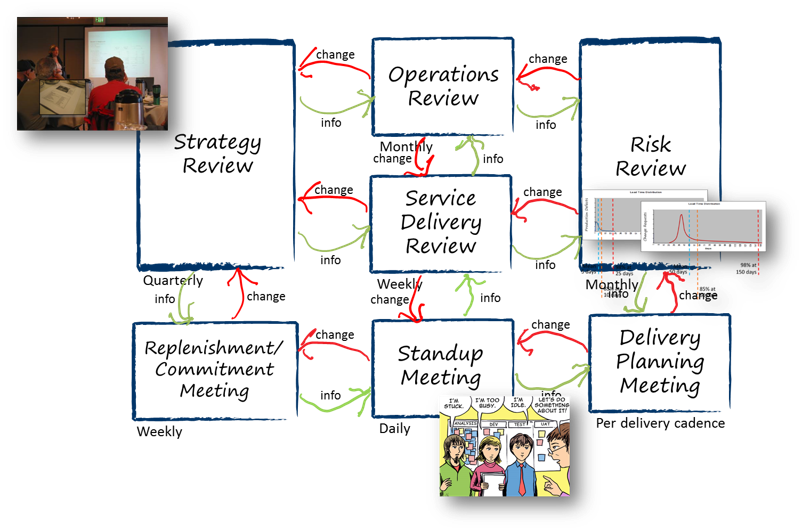Recently, I’ve taken a new approach to teaching The Kanban Method. The new Lean Kanban “Practicing the Kanban Method” class is built around the 7 Kanban Cadences – the cyclical meetings that drive evolutionary change and “fit for purpose” service delivery. Two of these meetings are relatively new additions to the method: Risk Review added in 2014 as a response to Klaus Leopold formalizing Blocker Clustering in 2013; and Strategy Review as an emergent response to the concept of “fit for purpose” and the need to sense the external environment, in order to be able to respond appropriately. The other 5 were existing elements of the method, though the first edition of my Kanban book ommitted Service Delivery Review. In truth our training has not until now emphasized these meetings and particularly replenishment/commitment and delivery planning have not been explicitly taught. Little wonder then that these very basic functions of Kanban have not been well implemented in the field.
When implementing the 7 cadences we don’t expect people to add seven new meetings to their organizational overhead. Instead we expect to find existing meetings that change be adapted and tuned up. Also at smaller scale we expect the meetings to be combined. We’ve also got one client who combined SDR with Replenishment/Commitment because the audience was the same. However, the SDR is on a bi-weekly cadence while Replenishment is weekly. To facilitate the combination they simply increase the meeting time by 30 minutes every other week. Delivery Planning is covered in the Kanban book but is for the first time being emphasized separately in training. Showing that Replenishment and Delivery Planning are separate meetings emphasizes the deferred delivery commitment taught in the class and really helps to underscore differences with methods such as Scrum where the two are combined and coupled together. By decoupling commitment to service a request from commitment to a specific delivery date, you can increase customer satisfaction by better managing their expectations and making promises you know you can keep. It’s been an important element of Kanban since 2006 and finally we are making it more explicit in our training.
There are 10 feedback loops on this diagram showing information flow and change request flows between the different meetings. Information flow is intended to facilitate decision making for example, output from a replenishment meeting would appear as information at a standup meeting. Change requests imply that something is not working well enough, that there is perception that some current policy is leading to an outcome that isn’t “fit for purpose,” for example, both SDR and Ops Review will provide capability information to a Strategy Review together with a requets for a change of strategy due to a lack of operational capability to deliver on current strategy.

